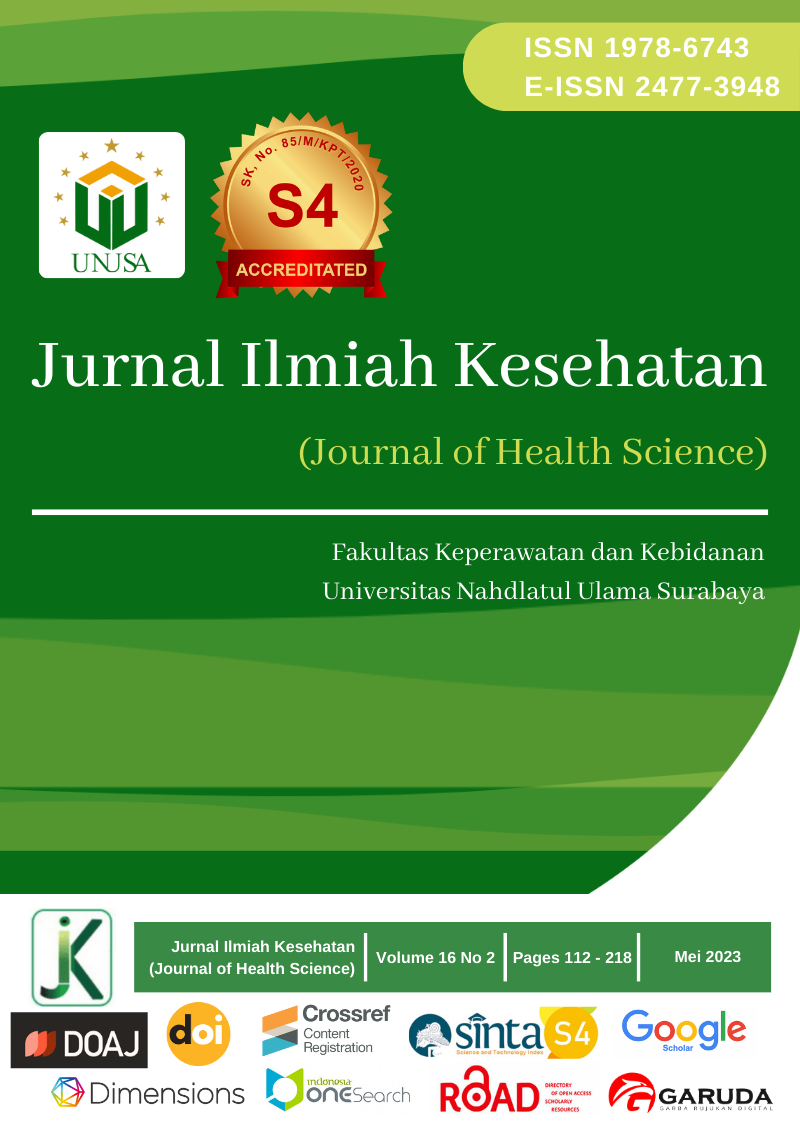Risk Factors for Stunting Among Children Under Five Years of Age in The Kokoda Tribe, Sorong City
Main Article Content
Abstract
Stunting is a chronic nutritional deficiency resulting in short stature and cognitive impairment. Sorong City has the highest incidence of very short and short toddlers in West Papua Province, 52.58%. This study analyzes the risk factors for stunting among children under five years of age in the Kokoda tribe, Sorong City. This study used a case-control design. The population was all parents and children aged 12-59 months registered at Integrated Health Post in 8 selected villages in Sorong City in 2021, totaling 1,890 children. There were 168 samples, 84 in the cases group and 84 in the control group, with the purposive sampling technique. Data collection used a stunting risk factors questionnaire on toddlers and measured body length, weight, and upper arm circumference. The data was processed by analyzing the Odds Ratio (OR) with the SPSS application. Results showed that children with birth lengths less than 48 centimeters had a 2.652 times greater risk of experiencing stunting compared to those more than equal to 48 centimeters. Children with birth weight less than 2,500 grams had a three times greater risk of stunting compared to those more than equal to 2,500 grams. Respondents with no clean water availability had 2.013 times more experienced stunting. Mothers not taking iron supplements during pregnancy could increase the risk of stunting three times. The risk factors for stunting among under-five children in the Kokoda tribe, Sorong City, are birth length, birth weight, the availability of clean water, and iron supplements during pregnancy.
Downloads
Article Details
Copyright (c) 2023 Radeny Ramdany , Norma

This work is licensed under a Creative Commons Attribution-ShareAlike 4.0 International License.
References
Abdullah, M., & Sari, E. R. (2017). Faktor-Faktor Yang Mempengaruhi Kejadian Stunting Pada Balita Di Wilayah Kerja Puskesmas Baiturrahman Kota Banda Aceh. Journal of Healthcare Technology and Medicine, 3(2), 368–374. DOI: https://doi.org/10.33143/jhtm.v3i2.1020
Andriansyah, A., Rate, S., & Yusuf, K. (2022). Hubungan Protein Kalsium Zink dan Vitamin D dengan Kejadian Stunting. Jurnal Ilmiah Kesehatan Diagnosis, 17(1), 19–26.
Apriluana, G., & Fikawati, S. (2018). Analisis faktor-faktor risiko terhadap kejadian stunting pada balita (0-59 bulan) di negara berkembang dan asia tenggara. Media Penelitian Dan Pengembangan Kesehatan, 28(4), 247–256. DOI: https://doi.org/10.22435/mpk.v28i4.472
Baidho, F., Sucihati, F., & Pratama, Y. Y. (2021). Hubungan Tinggi Badan Ibu Dengan Kejadian Stunting Pada Balita Usia 0-59 Bulan Di Desa Argodadi Sedayu BantuL. Jurnal Kesehatan Komunitas Indonesia, 17(1).
Budiastuti, I., & Rahfiludin, M. Z. (2019). Faktor risiko stunting pada anak di negara berkembang. Indonesia, K. K. R. (2018). Ministry of Health of the Republic of Indonesia. Center for Data and Information - Ministry of Health of the Republic of Indonesia. https://pusdatin.kemkes.go.id/article/view/18102500001/situasi-balita DOI: https://doi.org/10.20473/amnt.v3i3.2019.122-129
Nasir, M., Amalia, R., & Zahra, F. (2021). Kelas Ibu Hamil Dalam Rangka Pencegahan Stunting. Jurnal Pengabdian Dan Pemberdayaan Nusantara (JPPNu), 3(2), 40–45.
Office, W. P. H. (2021). Center for Data and Information - Ministry of Health of the Republic of Indonesia. https://pusdatin.kemkes.go.id/index.php?category=profil-kesehatan- kabupaten&provid=PV-032
Rahayu, R. M., Pamungkasari, E. P., & Wekadigunawan, C. S. P. (2018). The biopsychosocial determinants of stunting and wasting in children aged 12-48 months. Journal of Maternal and Child Health, 3(2), 105–118. DOI: https://doi.org/10.26911/thejmch.2018.03.02.03
Rahmadhita, K. (2020). Stunting problems and prevention. Jurnal Ilmiah Kesehatan Sandi Husada, 11(1), 225–229. DOI: https://doi.org/10.35816/jiskh.v11i1.253
Sudiarmanto, A. R. (2019). Hubungan Asupan Kalsium dan Zink dengan Kejadian Stunting Pada Siswi SMP Unggulan Bina Insani Surabaya. Universitas Airlangga. DOI: https://doi.org/10.20473/mgk.v9i1.2020.1-9
Supariasa, I. D. N., & Purwaningsih, H. (2019). Faktor-faktor yang mempengaruhi kejadian stunting pada balita di kabupaten malang. Karta Rahardja: Jurnal Pembangunan Dan Inovasi, 1(2), 55–64. DOI: https://doi.org/10.32883/mchc.v1i2.535
Tatu, S. S., Mau, D. T., & Rua, Y. M. (2021). Faktor-Faktor Resiko Yang Berhubungan Dengan Kejadian Stunting Pada Balita Di Desa Kabuna Kecamatan Kakuluk Mesak Kabupaten Belu. Jurnal Sahabat Keperawatan, 3(01), 1–17. DOI: https://doi.org/10.32938/jsk.v3i01.911
Usman, U., & Umar, F. (2020). Analisis Faktor Resiko Kejadian Stunting Pada Balita Di Kawasan Pesisir Kecamatan Suppa Kabupaten Pinrang. Jurnal Ilmiah Manusia Dan Kesehatan, 3(3), 432–443. DOI: https://doi.org/10.31850/makes.v3i3.528
Wahyuni, Y., Fasya, D. S., & Novianti, A. (2021). Analisis perbedaan asupan kalsium, magnesium, zink, dan aktivitas fisik berdasarkan kejadian dismenorea pada remaja putri atlet di SMA Negeri Ragunan. Ilmu Gizi Indonesia, 5(1), 71–80. DOI: https://doi.org/10.35842/ilgi.v5i1.213
Wulandari Leksono, A. (2021). Risiko Penyebab Kejadian Stunting pada Anak. Jurnal Pengabdian Kesehatan Masyarakat: Pengmaskesmas, 1(2), 34–38. DOI: https://doi.org/10.47710/abdimasnu.v1i1.135





